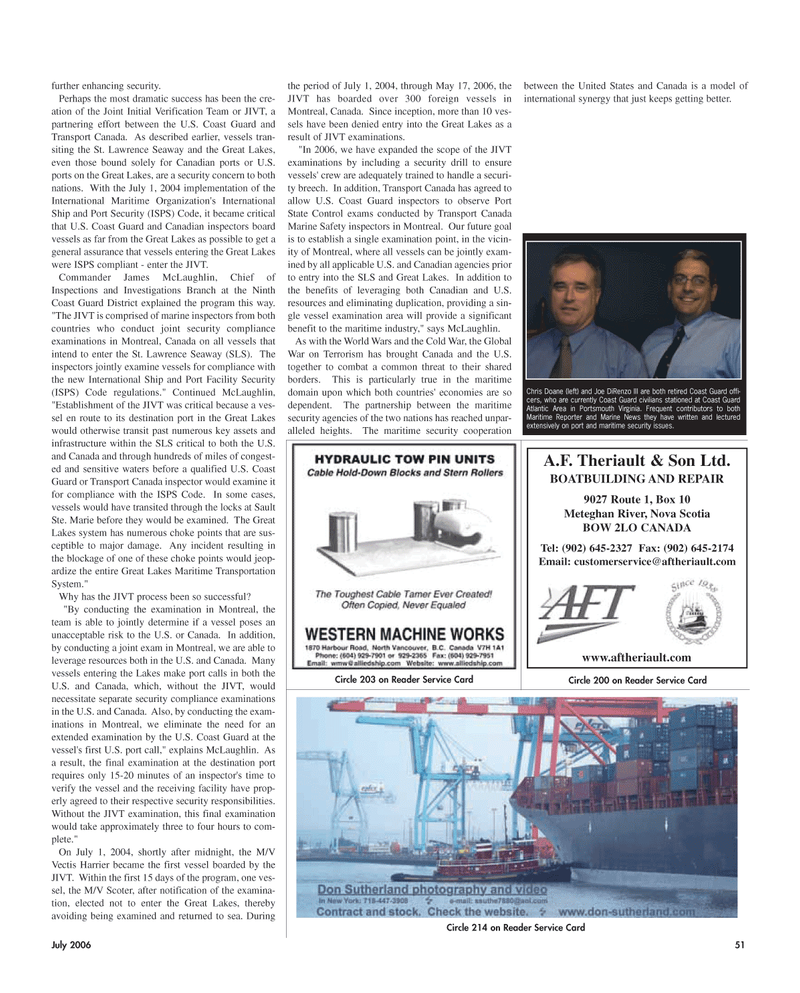
Page 51: of Maritime Reporter Magazine (July 2005)
The Satellite Communications Edition
Read this page in Pdf, Flash or Html5 edition of July 2005 Maritime Reporter Magazine
July 2006 51 further enhancing security.
Perhaps the most dramatic success has been the cre- ation of the Joint Initial Verification Team or JIVT, a partnering effort between the U.S. Coast Guard and
Transport Canada. As described earlier, vessels tran- siting the St. Lawrence Seaway and the Great Lakes, even those bound solely for Canadian ports or U.S. ports on the Great Lakes, are a security concern to both nations. With the July 1, 2004 implementation of the
International Maritime Organization's International
Ship and Port Security (ISPS) Code, it became critical that U.S. Coast Guard and Canadian inspectors board vessels as far from the Great Lakes as possible to get a general assurance that vessels entering the Great Lakes were ISPS compliant - enter the JIVT.
Commander James McLaughlin, Chief of
Inspections and Investigations Branch at the Ninth
Coast Guard District explained the program this way. "The JIVT is comprised of marine inspectors from both countries who conduct joint security compliance examinations in Montreal, Canada on all vessels that intend to enter the St. Lawrence Seaway (SLS). The inspectors jointly examine vessels for compliance with the new International Ship and Port Facility Security (ISPS) Code regulations." Continued McLaughlin, "Establishment of the JIVT was critical because a ves- sel en route to its destination port in the Great Lakes would otherwise transit past numerous key assets and infrastructure within the SLS critical to both the U.S. and Canada and through hundreds of miles of congest- ed and sensitive waters before a qualified U.S. Coast
Guard or Transport Canada inspector would examine it for compliance with the ISPS Code. In some cases, vessels would have transited through the locks at Sault
Ste. Marie before they would be examined. The Great
Lakes system has numerous choke points that are sus- ceptible to major damage. Any incident resulting in the blockage of one of these choke points would jeop- ardize the entire Great Lakes Maritime Transportation
System."
Why has the JIVT process been so successful? "By conducting the examination in Montreal, the team is able to jointly determine if a vessel poses an unacceptable risk to the U.S. or Canada. In addition, by conducting a joint exam in Montreal, we are able to leverage resources both in the U.S. and Canada. Many vessels entering the Lakes make port calls in both the
U.S. and Canada, which, without the JIVT, would necessitate separate security compliance examinations in the U.S. and Canada. Also, by conducting the exam- inations in Montreal, we eliminate the need for an extended examination by the U.S. Coast Guard at the vessel's first U.S. port call," explains McLaughlin. As a result, the final examination at the destination port requires only 15-20 minutes of an inspector's time to verify the vessel and the receiving facility have prop- erly agreed to their respective security responsibilities.
Without the JIVT examination, this final examination would take approximately three to four hours to com- plete."
On July 1, 2004, shortly after midnight, the M/V
Vectis Harrier became the first vessel boarded by the
JIVT. Within the first 15 days of the program, one ves- sel, the M/V Scoter, after notification of the examina- tion, elected not to enter the Great Lakes, thereby avoiding being examined and returned to sea. During the period of July 1, 2004, through May 17, 2006, the
JIVT has boarded over 300 foreign vessels in
Montreal, Canada. Since inception, more than 10 ves- sels have been denied entry into the Great Lakes as a result of JIVT examinations. "In 2006, we have expanded the scope of the JIVT examinations by including a security drill to ensure vessels' crew are adequately trained to handle a securi- ty breech. In addition, Transport Canada has agreed to allow U.S. Coast Guard inspectors to observe Port
State Control exams conducted by Transport Canada
Marine Safety inspectors in Montreal. Our future goal is to establish a single examination point, in the vicin- ity of Montreal, where all vessels can be jointly exam- ined by all applicable U.S. and Canadian agencies prior to entry into the SLS and Great Lakes. In addition to the benefits of leveraging both Canadian and U.S. resources and eliminating duplication, providing a sin- gle vessel examination area will provide a significant benefit to the maritime industry," says McLaughlin.
As with the World Wars and the Cold War, the Global
War on Terrorism has brought Canada and the U.S. together to combat a common threat to their shared borders. This is particularly true in the maritime domain upon which both countries' economies are so dependent. The partnership between the maritime security agencies of the two nations has reached unpar- alleled heights. The maritime security cooperation between the United States and Canada is a model of international synergy that just keeps getting better.
Circle 214 on Reader Service Card
Circle 203 on Reader Service Card Circle 200 on Reader Service Card
A.F. Theriault & Son Ltd.
BOATBUILDING AND REPAIR www.aftheriault.com 9027 Route 1, Box 10
Meteghan River, Nova Scotia
BOW 2LO CANADA
Tel: (902) 645-2327 Fax: (902) 645-2174
Email: [email protected]
Chris Doane (left) and Joe DiRenzo III are both retired Coast Guard offi- cers, who are currently Coast Guard civilians stationed at Coast Guard
Atlantic Area in Portsmouth Virginia. Frequent contributors to both
Maritime Reporter and Marine News they have written and lectured extensively on port and maritime security issues.
MR JULY2006 #7 (49-56).qxd 7/5/2006 12:07 PM Page 51

 50
50

 52
52
